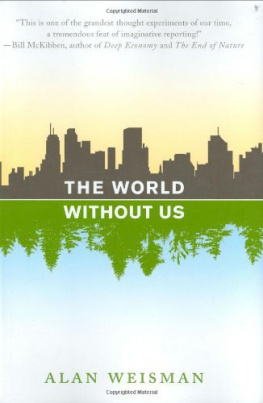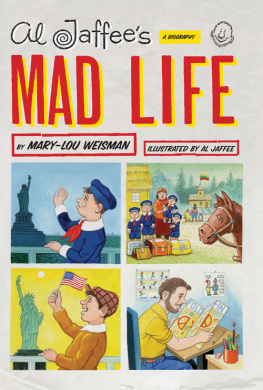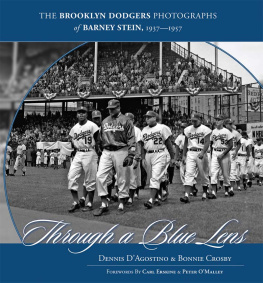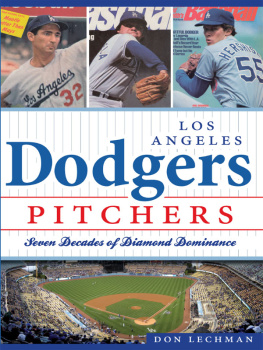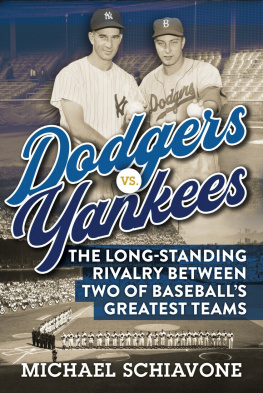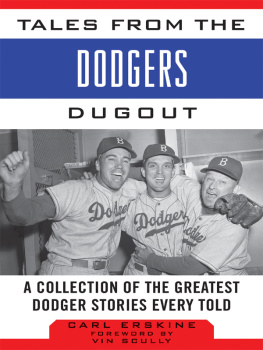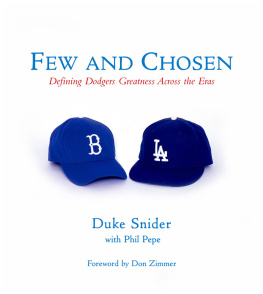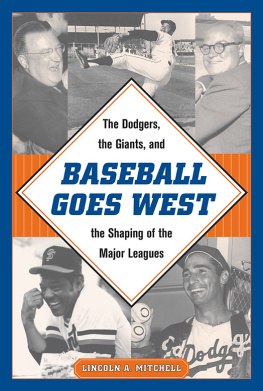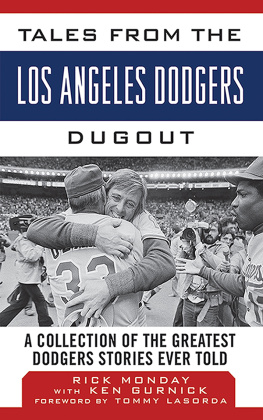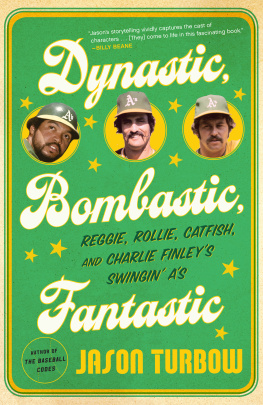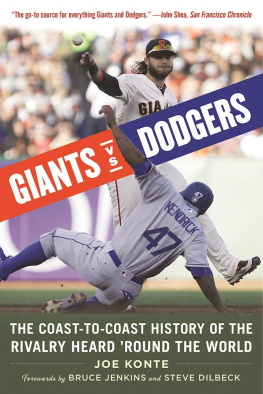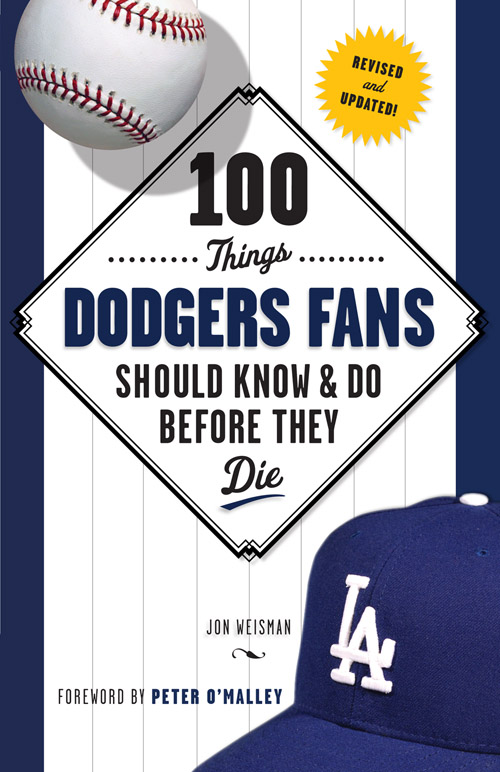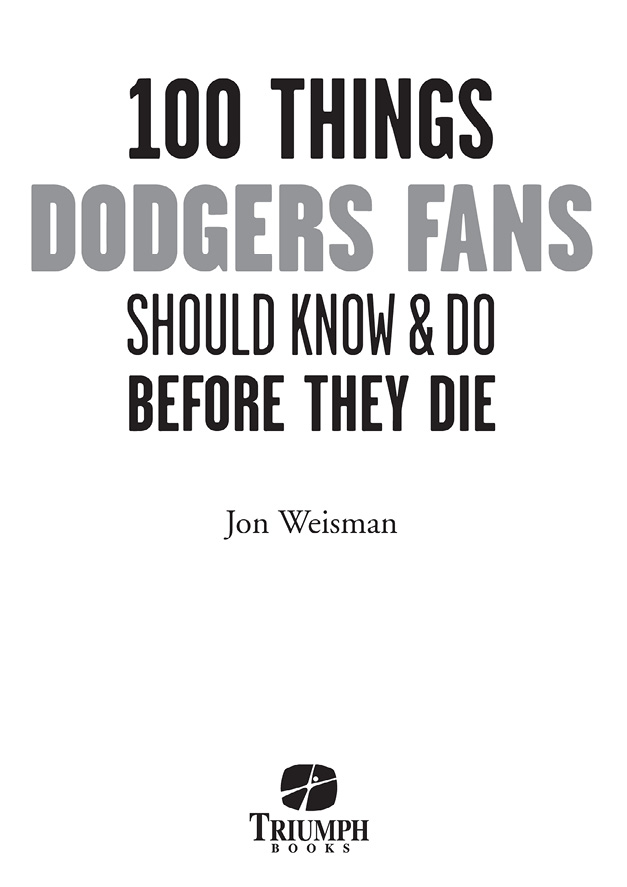
To Dad, who made my childhood jaw drop when he could quote Walter Johnsons strikeout totals from memory; to Mom, who would cut my morning toast into a ballfield if I asked; to Greg, who has brought joy to Mudville my entire life; and to Robyn, who taught me that if you want to play catch, you have to go after it yourself.
To Dashiell, whose sublime babyhood allowed me to work in peace in the wee hours; to Casey, my happy, happy boy; and to Lilah, my sweet, sweet little girl.
And to Dana, my love, my one and only, who is more special to me than words can say.
Contents
Foreword by Peter OMalley
Several years ago, I was introduced to the website DodgerThoughts.com and writer Jon Weisman. I was immediately impressed with Jons passion, commitment, and analysis of the Dodger organization. Now he has been given the most challenging assignment to list 100 Things Dodgers Fans Should Know & Do Before They Die . Even with his selected 100 key items, I suspect that individual Dodgers fans will keep adding more from personal memories.
However, Jon has captured the disappointment of the 1951 and 1962 pennant races while sharing the excitement of Dodger World Series championships in 1955, 1959, 1963, 1965, 1981, and 1988. From the Captain Pee Wee Reese, to the grace and elegance of center fielder Duke Snider, to the all-out competitiveness of Jackie Robinson; to the courage and indomitable spirit of Roy Campanella; to dominating pitchers Sandy Koufax and Don Drysdale; to the leadership of managers Walter Alston and Tommy Lasorda; to the consistency of Don Sutton; to the famous infield of Garvey, Lopes, Russell, and Cey; to the sheer drama of Kirk Gibsons 1988 Game 1 World Series home run and Orel Hershisers Cy Young season; to Fernandomania, Nomomania, and beyond; Dodger baseball has fascinated us all. This book will be appreciated by baseball fans of all ages.
So, sit back and pull up a chair as our friend and Hall of Fame broadcaster Vin Scully would say. Happy readingIts time for Dodger baseball!
Peter OMalley
President
Los Angeles Dodgers, 197098
Introduction
In my childhood, there was time for everything. The Dodgers were part of that ensemble cast, one of many pastimes I could devote myself to after (or before, or during) my homework. Given that, in many ways, my childhood lasted past my 30 th birthday, this meant years and years of unbridled involvement.
Marriage, children, and, after much resistance, a tumble from the freelance control-your-own-destiny world into the hopeless ranks of the salaried decimated my free time. No longer could I check all of the above for hobbies. I had to pick and choose my interests carefully. Of course, ultimately they pick themselvesthe things that are most important to you stay with you. And while much left me, the Dodgers stuck around, deep.
In fact, beginning in 2002, I started to spend more time pondering the Dodgers than ever before. At a time most people had still not heard of the word, I started a blog called Dodger Thoughts (www.dodgerthoughts.com), where I would pass along notes and essays about the team and express views the mainstream press didnt. Youd think youd run out of things to say but, on the contrary, no matter how pressing daily life might be, the Dodgers demanded a daily examination and re-examination in every wayfrom what happens in the games to what happens in the stands, from the present to the past, from the personnel moves to what to do about all those beach balls. The Dodgers arent the only epic story around, but theyre a pretty great onewith fantastic characters, emotions, and plot twists that are nearly impossible to abandon (even if, since 1988, it turned rather Dostoyevskian). Whenever I wonder why Im watching a Dodger game instead of doing, I dont know, any of a million other things like going for a hike or doing something constructive for society, I find theres just too much here to let go of. Why even have a society if we cant use it to follow the Dodgers? This book, 100 Things Dodgers Fans Should Know & Do Before They Die , speaks to this tenuously rational but undeniable pull the Dodgers have.
Now, the risk of a book in this format is that the more of a Dodgers fan you are, the less you would need to be told whats important about them, and so instead of being all things to everyone, the book ends up being nothing to anyone. And thats bad for sales. The task, then, is to reverse that, to give the diehards something new to chew on while also showing those casual or even antagonistic about the Dodgers whats worth understanding about them. (Attention, San Francisco bookstore patrons: Know thy enemy!) This book is not a laundry list where youre simply told that Jackie Robinson broke baseballs modern-day color barrier or Kirk Gibson hit a big home run. Its an attempt to go wider and deeper, to rethink or re-experience the familiar, and introduce or remind us of the not-so-familiar so that everyone can benefitfrom the Dodger fan with all the time in the world to the one who will only read one baseball book a year. I hope this book fulfills that mission.
If nothing else, hidden in these pages are my favorite, underused, avoid-the-traffic routes to Dodger Stadium. The book might be worth keeping handy just for that!
A Word about Statistics
Throughout 100 Things Dodgers Fans Should Know & Do Before They Die , traditional baseball statistics will be augmented by more recently developed stats, most often Total Average (TAv) and adjusted on-base percentage plus slugging percentage (OPS+). Heres what they mean and why theyre being used.
TAv, created by Baseball Prospectus, and OPS+, which youll find at Baseball-Reference.com, are means to measure offensive performance across different years and ballparks. In particular, 20 homers from a batter hitting in Dodger Stadium in the 1960s is a greater accomplishment than 20 homers from a batter hitting in Dodger Stadium in the 1990s, because it simply was harder to hit the ball out of the park in the prior era.
Taking into account these factors, TAv expresses a batters offensive value in a number designed to resemble batting averagean average TAv is .260, anything at .300 or above is excellent, anything below .200 is awful. OPS+ is similar, though it doesnt take base running into account. An average OPS+ is 100anything higher than 100 is above the league average, and anything lower is below.
So, for example, Wes Parker, who batted .238 with eight homers for the 65 Dodgers, had a .276 TAv and 100 OPS+, while Eric Karros, who seemingly had a better season with the 2002 Dodgers by hitting .271 with 13 homers, actually comes in behind Parker with a .260 TAv and 96 OPS+. (It should also be noted that even when citing traditional stats, 100 Things will lean toward on-base percentage rather than batting average for a truer snapshot of a players ability to avoid getting out.)
For pitchers, adjusted earned-run average (ERA+) from Baseball-Reference.com works on a similar principle, recalculating traditional ERAs so that they can be compared across time and space more fairly. One reminder: Higher is better. An ERA+ above 100 means that the pitcher was above-average.
These statistics arent the be-all and end-all, but they do provide a more accurate means of understanding how different Dodgers performed. For those who havent seen them before, heres hoping youll give them a try.
1. Jackie
From beginning to end, we root for greatness.
We root for our team to do well. We root for our team to create and leave lasting memories, from a dazzling defensive play in a spring training game to the final World Series-clinching out. With every pitch in a baseball game, were seeking a connection to something special, a fastball right to our nervous system.



